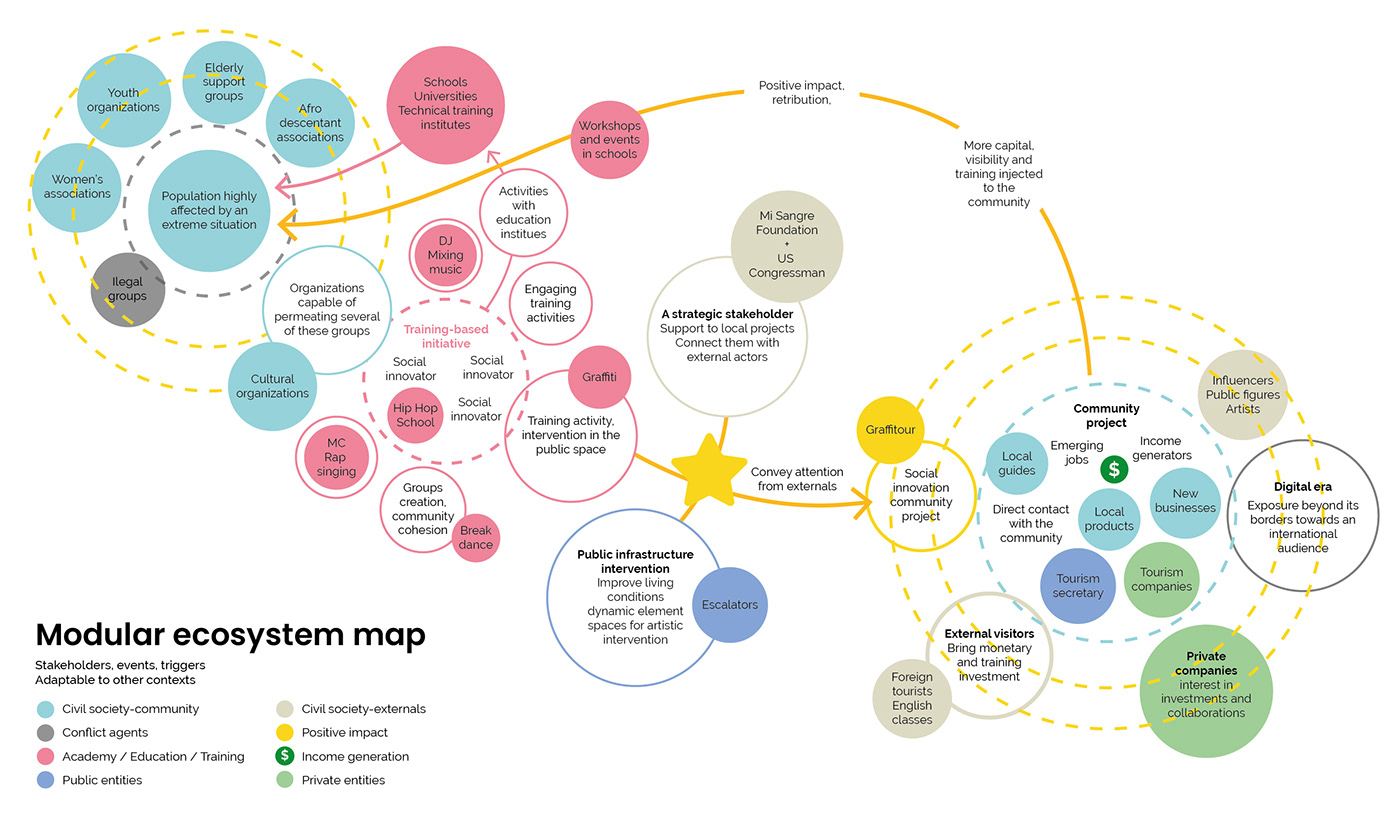Graffitour Latam
A design research project aiming to replicate social innovation across Latin America
📍Medellín, Colombia
The challenge:
Replicate "Graffitour Comuna 13" project as a brand in other latin-american cities.
Originated in Medellin, Colombia, it is a project that combines public investment, education, art, community tourism and private investment, which provoked a social transformation from a vulnerable community to being one of the main touristic attractions in the city.
The solution:
Proposal of several strategies to replicate from a design perspective: creation of a modular ecosystem map, scenarios, roadmap, social innovation model and metaphorical conclusion.

Context:
In what was the poorest and most dangerous neighborhood in the city, a group of urban artists rises up leveraging on the construction of the first escalators in an urban space in the world (2011) which attracted foreign attention. This artistic collective created a tour of graffiti and transformed it into one of the main tourist attractions in the city, visited by people from all over the world, which has created an incredible progress in the community,
Project carried out during the internship at the start-up Fruta: “design and innovation for sustainability", in collaboration with the movement "Protagonistas del progreso" who support social leaders in Latin America, and as a thesis project for the Product-Service System Design master's degree.
http://fruta.global/
https://protagonistasdelprogreso.com/
https://www.instagram.com/graffitourcasakolacho/

The project process

Pictures from the fieldwork done in July 2022







Key timeline events of the neighborhood


The case studies showed that, beyond the approaches of top-down and bottom up, the key for positive social transformations would be an evolution of these, by boosting efforts and actions both from the top (government, companies, academy) and the bottom (inhabitants, artistic collectives)

Social innovation impact analysis
It was done to determine the impact of Graffitour and the transformation in commune 13 in 7 different aspects: capacity, wellness, participation, assets, identity and inclusion, environment and entrepreneurship


Understand
1. Modular ecosystem map
In this map I visualize the stakeholders, events and triggers that made possible the transformation, according to desk, field research and interviews

Understand
2. Stakeholders roles map
In this map I show the different stakeholders involved in the transformation and their specific contribution to the community and the emergence of the Graffitour project

Replicate
1. Scenarios
These scenarios aim to propose 3 different alternatives on
"How might we generate progress in vulnerable communities in Latam?"



Replicate
2. Roadmap
This roadmap proposes a set of steps to create a transformation towards social innovation. It was built based on:
- Graffitour Founders Methodologies (2022)
- Suggestions from the leader of the local NGO "Comuna Project" (Piedrahita, 2022)
- Theory about autonomous design, asset-based approach for vulnerable communities (Escobar, 2018)
- Complex Participatory Design (Deserti & Rizzo, 2014)
- Social innovation (Selloni & Rossi, 2019)
- Suggestions from the leader of the local NGO "Comuna Project" (Piedrahita, 2022)
- Theory about autonomous design, asset-based approach for vulnerable communities (Escobar, 2018)
- Complex Participatory Design (Deserti & Rizzo, 2014)
- Social innovation (Selloni & Rossi, 2019)

Replicate
3. Multi-stakeholers collaboration model
This model proposes a non-linear approach where actions can be taken at different points and from different actors. The aim is to create a social innovation community project based on the construction of a long term bond between the stakeholders


Model phases


Which would be some first steps to get started?
Here I propose a series of concrete actions that could be taken from "Protagonistas del Progreso" and the founders of Graffitour to start expanding the project in new territories.

Methaphoric synthesis
In this synthesis, I use the metaphor of painting a graffiti mural to show the different components that made possible this social innovation project.













